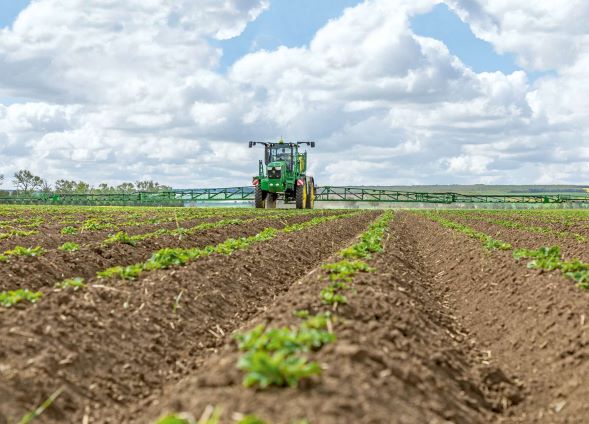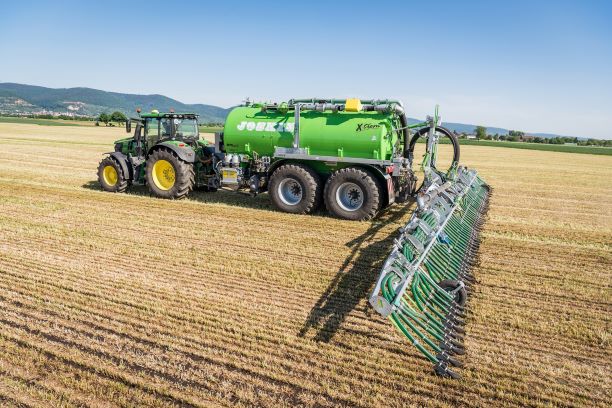Sustainable Economy with Smart Technology
 Farmers are constantly faced by various challenges, with climate change and agriculture’s carbon footprint the latest of these. With politicians and consumers now calling for more sustainable food production, agriculture must continue to feed the growing global population and deal with the consequences of climate change.
Farmers are constantly faced by various challenges, with climate change and agriculture’s carbon footprint the latest of these. With politicians and consumers now calling for more sustainable food production, agriculture must continue to feed the growing global population and deal with the consequences of climate change.
At the company’s first Sustainability Day, John Deere discussed with farmers, advisors and experts how the agricultural machinery industry can contribute to finding a better balance between economy and ecology. In particular, digital solutions can reduce environmental impacts and help farmers to achieve the same or even higher yields with less use of mineral fertilisers, agrochemicals and fuel.
Opening the event, Markwart von Pentz, President of John Deere’s Ag Division, and Professor Peter Pickel, responsible for future technologies, explained the potential of digital solutions as well as how agriculture will continue to change.
“Precision Ag enables farmers to combine efficient field work with environmental and nature protection,” said Peter Pickel. “Using these technologies, by 2030 CO2 emissions can be sharply reduced by as much as 11 per cent.”
Markwart von Pentz stated that famers will become climate savers and added: “Digitalisation is a key enabler to make farming more sustainable. It also provides better transparency through enhanced documentation. In this way, farmers will be able to regain consumer confidence.”
During the Sustainability Day, John Deere identified three areas that have a particular impact on the sustainability of agriculture:
- Soil protection – protecting the soil with modern design concepts;
- Fertilisation – using digital nutrient measurement to upgrade manure and slurry as a valuable organic fertiliser;
- Crop protection – reducing the use of agrochemicals by more precise applications.
Increased Soil Protection
Soil protection is mainly about using larger machinery footprints, which helps to avoid damaging soil compaction. This ensures greater soil fertility while increasing porosity and the soil’s capacity to store more nutrients and water.
In recent years, tractors have undoubtedly become heavier. Nevertheless, soil compaction has steadily decreased due to the use of larger tyres and the ability to work with low inflation pressures. For example, a modern 22-tonne tractor only puts a pressure of 0.6kg/cm² on the ground, while a 3-tonne 75hp tractor built in the 1970s applies much more weight, at 1.5kg/cm².
Tracked tractors are even gentler on the soil. The new John Deere four-track 8RX has a huge footprint of 4.6m², so the contact surface pressure is very low at only 0.4kg/cm². A larger footprint also means less track depth, which reduces compaction in the deeper soil layers and reduces roll resistance.
Less roll resistance means lower fuel consumption and therefore fewer CO2 emissions. Tests have shown that fuel consumption can be reduced in this way by 10 per cent, so this innovative driving concept can make an active contribution to climate protection.
Fertilising More Accurately With Manure
Fertilising farmland with manure is often the subject of critical public debate. There’s no doubt that slurry is a valuable organic fertiliser that needs to be used correctly. However, this only works if the farmer is able to determine the nutrient demand of the crop as well as the nutrient content of the manure.
Today, both can be measured accurately by taking soil and plant samples. The results allow farmers to create application maps, which make site-specific fertiliser applications possible.
With the John Deere HarvestLab sensor, the precise nutrient content of the manure can be accurately measured. The sensor’s NIR technology identifies the exact amounts of nitrogen, phosphorus and potassium, even when the values vary. Controlled in real time by these active measurements and the application map recommendations, the tractor and slurry tanker are able to adjust the application rate automatically. This ensures the exact amount of organic fertiliser is applied according to the specific needs of the crop.
Over- and under-fertilisation is prevented, which avoids both air and water pollution, and the use of mineral fertilisers can be significantly reduced. Ultimately the environment will also benefit, since the production of fertilisers uses a lot of energy and generates a lot of CO2.
Targeted Crop Protection
Overlaps and overdoses of agrochemicals should also be avoided. Technologically, these problems can be solved by accurate GPS-controlled driving with AutoTrac, intelligent SectionControl and John Deere’s ExactApply individual nozzle control. At the same time, there is a growing trend towards the use of site-specific or even individual plant treatments instead of uniformly spraying complete fields.
Site-specific applications divide fields into zones that can be treated differently. Drones or satellite images, for example, can measure crop density and related disease pressure, so the necessary fungicides can be applied. Again based on application maps, sections of the field are only treated where necessary. This approach can provide massive cost savings, depending on crop and field variations.
John Deere’s new See & Spray technology is even more precise. High-speed cameras and artificial intelligence help to capture crop populations, and See & Spray Select can identify weeds and apply a herbicide at specific locations across the field.
The next step up is the advanced See & Spray system, which can distinguish between weeds and the growing crop. Again, only the individual weeds are treated, while the crop is not affected. See & Spray technology is currently developed for row crop applications, and herbicide savings of up to 90 per cent are possible.
Mechanical weed control also benefits from the use of high-speed camera technology. The AutoTrac Implement Guidance system provides precise control of mechanical hoes used between crop rows. The system’s accuracy allows the tractor to be driven at high speeds of up to 16kph. For organic farms in particular, this technology offers a real efficiency advantage. Even conventional farms can benefit by combining chemical and mechanical measures, and therefore significantly reduce the cost and environmental burden of herbicide use.
These technologies cannot on their own contribute to the total climate neutrality of agriculture. However, they can help to reduce fertiliser, agrochemical and fuel costs, and significantly reduce farming’s carbon footprint. Farmers are certainly willing to produce food and energy more sustainably. This approach calls for action by all participants to set a new course for European agriculture in such a way that a successful balance can be struck between economy and ecology.
Based On Source: (John Deere) (OUR NEXT LEAP: BOOSTING ECONOMIC VALUE AND SUSTAINABILITY FOR OUR CUSTOMERS) ([https://www.deere.com/en/stori...])













